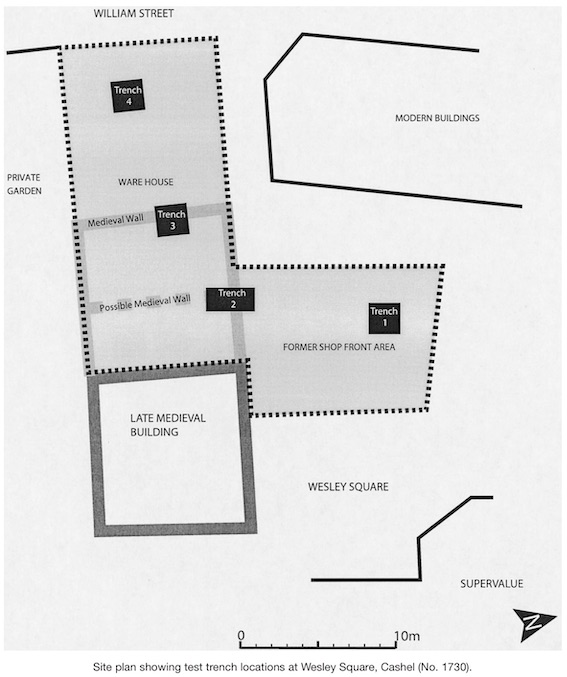County: Tipperary Site name: CASHEL: Wesley Square
Sites and Monuments Record No.: TS061-025---- Licence number: 03E1831
Author: Richard Clutterbuck, Cultural Resource Development Services Ltd.
Site type: Historic town
Period/Dating: Multi-period
ITM: E 607448m, N 640537m
Latitude, Longitude (decimal degrees): 52.516157, -7.890254
An assessment of the site of the former McInerney & Sons Ltd premises, Wesley Square, Cashel, Co. Tipperary, was undertaken in September and November 2003. The site is within the medieval walls of Cashel and adjoins a standing medieval building. It is currently occupied by a disused furniture store and warehouse. The initial desktop survey identified McInerney & Sons as the former site of a Methodist chapel, a medieval building and at least two modern houses; previous excavations in the vicinity had uncovered a significant amount of archaeological stratigraphy. The testing strategy was designed to investigate these elements of the site. The excavation was carried out from 17 to 20 November inside the existing buildings. Four trenches were excavated: three measured 2m by 2m (Trenches 1, 3 and 4) and one measured 1.5m by 3m (Trench 2); the trenches were excavated with the assistance of a mini-digger and halogen lamps.
Forty archaeological features were identified from the modern concrete floor slab, a 19th-century cobbled surface, 17th- or 18th-century garden soils, thick medieval walls and floor surfaces, refuse layers and the natural subsoil. The modern floor of the site consists of a c. 0.2m-deep layer of concrete with a gravel and rubble deposit beneath. Walls, most likely from the demolished medieval building, were encountered in Trenches 2 and 3 quite close to the modern surface, between 0.29 and 0.38m beneath the current floor surface; Trench 2 picked up the junction of two walls. The full width of these walls was not revealed, but they appeared to be at least 1m thick. These walls appear to have been demolished immediately before the construction of McInerney's in the 1960s or 1970s. The old floor surface of the medieval building was found at a depth of c. 0.76m beneath the concrete floor; the wall foundation was built to subsoil level 1.3m beneath the current site floor level. Cobble and mortar floor surfaces were found in Trench 1; these appear to relate to 19th- and 20th-century structures, most probably the Methodist church built in or around 1833 and demolished to make way for McInerney's.
These modern floors sealed a number of medieval deposits or fills at a depth of c. 0.4m beneath the current floor surface. These features contained pottery and a knife, as well as the partial remains of a human skull placed up-side-down within the fill of a pit or ditch.
The stratigraphy in Trench 4 at the western end of the site also indicated the presence of surfaces probably associated with the structures depicted in the OS maps from the 19th and 20th century. These surfaces are separated by a c. 0.16m-deep layer of dark garden soil, indicating a period of abandonment of these buildings. Another layer of dark soil, c. 0.32m deep, indicates that this area was used as a garden in the 16th to 18th century. A number of small medieval features were found cut into the natural subsoil beneath this garden soil.
In total, 25 artefacts were recovered. All were pottery, with the exception of a medieval iron knife recovered from Trench 1. The ceramic finds consist of nineteen sherds of modern pottery, one sherd of early modern and four sherds of medieval pottery. The modern pottery consists mainly of fine white fabric earthenwares such as pearlware and blue transfer print pottery, both of which date to the 18th–20th century. Several sherds of creamware were also recovered. Less expensive pottery types found consisted of white stoneware, coarse fabric red earthenware and blackware. A single sherd of 16th/17th-century pottery with a buff fabric and a clear lead glaze was recovered from the lower fills of Trench 4. The two sherds of medieval pottery recovered consisted of a sherd of Saintonge green-glazed pottery and a sherd of a wheel-thrown vessel with an external green glaze, which may be a local pottery type from the 13th to 14th century.

Unit 4, Dundrum Business Park, Dundrum, Dublin 14